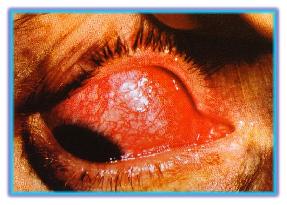| Sckeritis can be
classified as anterior or posterior. Anterior scleritis
is divided into sectoral, diffuse, nodular and
necrotizing subtypes. Patients present with deep,constant
pain in the involved eye. The disease can be bilateral in
50% of patients. It occurs predominantly in women and
varies from mild forms to very severe forms that can
destroy the eye. With active inflammation,the sclelra has
a violaceous hue best seen lin naturnal sunlight.
Engorgement of the deep vascular plexus is evident,as
shown in the slide;the engorgned vessels do not move when
the overlying tissues are moved with a cotton-tipped
applicator. Nodular anterior scleritis is most commonly
seen in association with rheumatoid arthritis. The more
destructive necrotizing scleritis can be associated with
substantial loss of vision. The patient's life expectancy
has been shown to be adversely affected by uncontrolled
associated systemic autoimmune disease. Posterior scleritis almost always
presents with pain,tenderness,and proptosis. Choroidal
folds,exudaive retinal detachment and papilledema van
also occur.
Complications of scleritis
include Keratitis, uveitis, cataract, glaucoma, scleral
thining, marginal Keratolysis and scleral perforation.
The disease can occur as an isolated phenomenon or in
association with various systemic autoimmune diseases,
such as rheumatoid arthritis, Wegener's granulomatosis,
polyartheritis nodosa, systemic lupus erythematosus,
herpes zoster ophthalmicus, syphilis, tuberculosis and
gout. Milder cases respond to topical steroid therapy.
Although definitive
treatment varies according to cause,treatment sometimes
involves nonsteroidal anti-inflammatory agents, systemic
steroids, and, for the progressive cases,
immunosuppressive aggents. Appropriate treatment of
associated systemic autoimmune diseases is also
important.
|
 |

